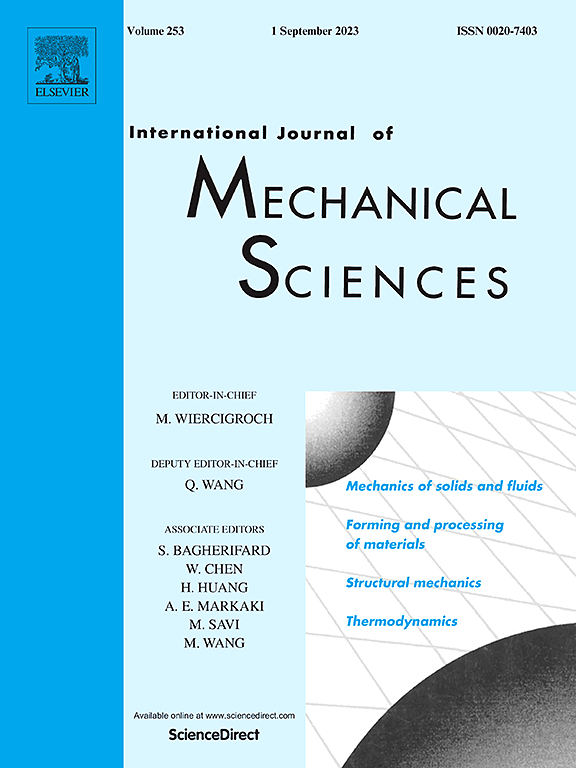雷诺数对4:1矩形圆柱绕流的影响
IF 7.1
1区 工程技术
Q1 ENGINEERING, MECHANICAL
International Journal of Mechanical Sciences
Pub Date : 2025-06-24
DOI:10.1016/j.ijmecsci.2025.110541
引用次数: 0
摘要
采用二维(2D)层流和三维(3D)大涡模拟(LES)方法,全面研究了雷诺数Re = 1-1.2 × 105时4:1矩形圆柱的均匀流动动力学和气动特性。发现了四种不同的流动形式:稳定流动(形式Ⅰ,Re <;92),非定常层流(状态Ⅱ,92≤Re <;4.5 × 102),尾流过渡(RegimeⅢ,4.5 × 102≤Re <;7.0 × 102),剪切层过渡(RegimeⅣ,7.0 × 102≤Re≤1.2 × 105)。在制度I中,对于Re <;3(状态I-a),流动完全附着在表面,即“爬行”流动;为3≤Re <;92(状态Ⅰ-b),流动从尾缘分离,在尾迹中形成一个稳定的再循环区域,即稳定分离状态。在RegimeⅡ中,对于92≤Re <;1.2 × 102(状态Ⅱ-a),气流从尾缘角分离,形成层流Kármán涡旋;为1.2 × 102≤Re <;3.0 × 102 (RegimeⅡ-b)时,气流从前缘角分离,以对称稳定分离气泡重新附着在侧表面,再从尾缘角分离;3.0 × 102≤Re <;4.5 × 102 (RegimeⅡ-c),流动从Kármán涡旋转变为撞击前缘涡(ILEV)不稳定,导致斯特罗哈尔数(St)从0.162 (Re = 2.75 × 102)突然下降到0.130 (Re = 3.0 × 102)。在Ⅲ状态下,尾流涡由层流向湍流过渡,具有ILEV不稳定性。在RegimeⅣ中,分离的剪切层向湍流过渡,随着Re的增加,过渡位置向上游移动。本文章由计算机程序翻译,如有差异,请以英文原文为准。

Reynolds number effects on the flow around a 4:1 rectangular cylinder
Two-dimensional (2D) laminar and three-dimensional (3D) large-eddy simulations (LES) are performed to comprehensively investigate the flow dynamics and aerodynamic characteristics of uniform flow around a 4:1 rectangular cylinder at Reynolds number Re = 1–1.2 × 105. Four distinct flow regimes are found: steady flow (Regime Ⅰ, Re < 92), unsteady laminar flow (Regime Ⅱ, 92 ≤ Re < 4.5 × 102), wake transition (Regime Ⅲ, 4.5 × 102 ≤ Re < 7.0 × 102), and shear layer transition (Regime Ⅳ, 7.0 × 102 ≤ Re ≤ 1.2 × 105). In Regime I, for Re < 3 (Regime I-a), flow fully attaches to surfaces, namely 'creeping' flow; for 3 ≤ Re < 92 (Regime Ⅰ-b), flow separates from trailing edges, forming a steady recirculation region in the wake, namely steady separated regime. In Regime Ⅱ, for 92 ≤ Re < 1.2 × 102 (Regime Ⅱ-a), flow separates from trailing-edge corners and forms laminar Kármán vortices; for 1.2 × 102 ≤ Re < 3.0 × 102 (Regime Ⅱ-b), flow separates from leading-edge corners, reattaches to lateral surfaces with symmetrical steady separation bubbles, and separates again from trailing-edge corners; for 3.0 × 102 ≤ Re < 4.5 × 102 (Regime Ⅱ-c), flow changes from Kármán vortices to impinging-leading-edge-vortex (ILEV) instability, causing Strouhal number (St) to suddenly drop from 0.162 (Re = 2.75 × 102) to 0.130 (Re = 3.0 × 102). In Regime Ⅲ, wake vortices transition from laminar to turbulence with ILEV instability. In Regime Ⅳ, separated shear layers transition to turbulence, and transition position moves upstream as Re increases.
求助全文
通过发布文献求助,成功后即可免费获取论文全文。
去求助
来源期刊

International Journal of Mechanical Sciences
工程技术-工程:机械
CiteScore
12.80
自引率
17.80%
发文量
769
审稿时长
19 days
期刊介绍:
The International Journal of Mechanical Sciences (IJMS) serves as a global platform for the publication and dissemination of original research that contributes to a deeper scientific understanding of the fundamental disciplines within mechanical, civil, and material engineering.
The primary focus of IJMS is to showcase innovative and ground-breaking work that utilizes analytical and computational modeling techniques, such as Finite Element Method (FEM), Boundary Element Method (BEM), and mesh-free methods, among others. These modeling methods are applied to diverse fields including rigid-body mechanics (e.g., dynamics, vibration, stability), structural mechanics, metal forming, advanced materials (e.g., metals, composites, cellular, smart) behavior and applications, impact mechanics, strain localization, and other nonlinear effects (e.g., large deflections, plasticity, fracture).
Additionally, IJMS covers the realms of fluid mechanics (both external and internal flows), tribology, thermodynamics, and materials processing. These subjects collectively form the core of the journal's content.
In summary, IJMS provides a prestigious platform for researchers to present their original contributions, shedding light on analytical and computational modeling methods in various areas of mechanical engineering, as well as exploring the behavior and application of advanced materials, fluid mechanics, thermodynamics, and materials processing.
 求助内容:
求助内容: 应助结果提醒方式:
应助结果提醒方式:


